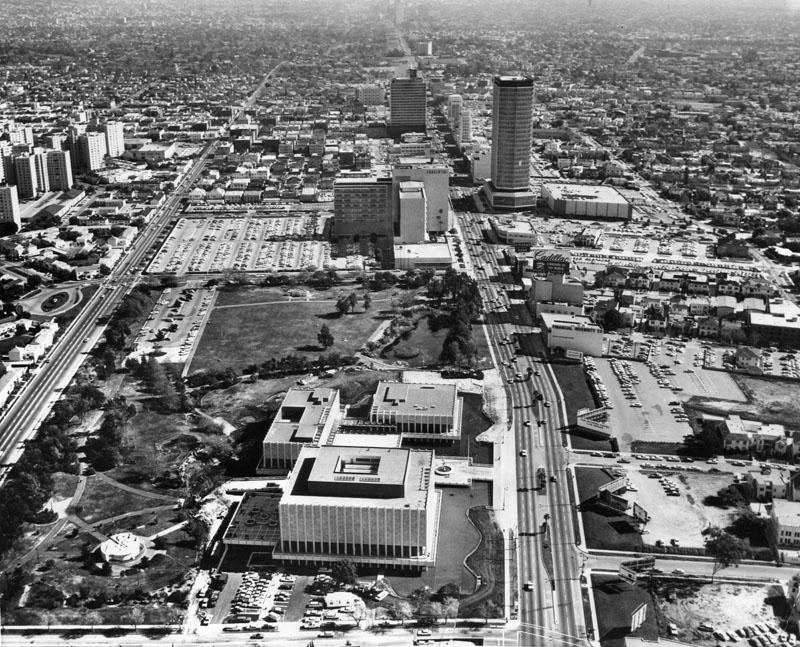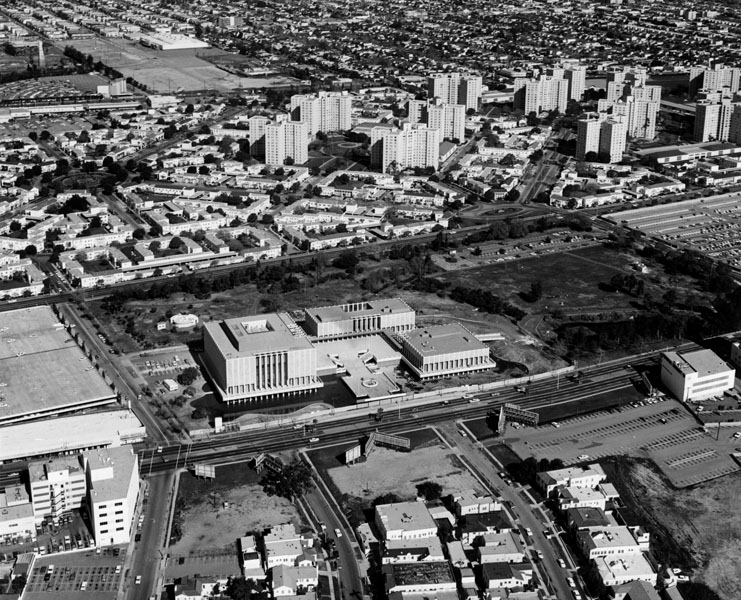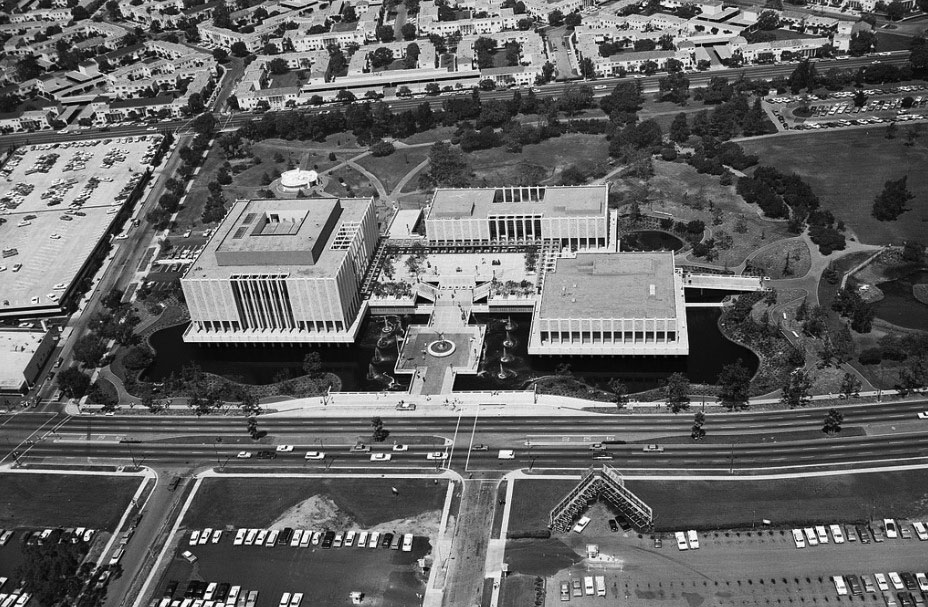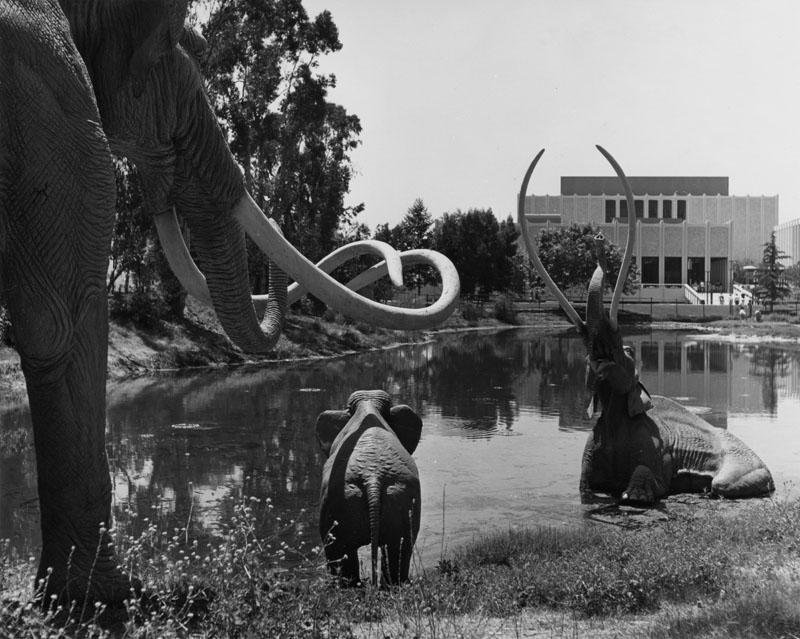Los Angeles County Museum of Art (LACMA)
 |
|
| (1964)* - Statues of prehistoric beasts graze on banks of pool in Hancock Park with the construction of the Los Angeles County Museum of Art (LACMA) seen in the background. |
Historical Notes The Los Angeles County Museum of Art was established as a museum in 1961. Prior to this, LACMA was part of the Los Angeles Museum of History, Science and Art, founded in 1910 in Exposition Park near the University of Southern California. Howard F. Ahmanson, Sr., Anna Bing Arnold and Bart Lytton were the first principal patrons of the museum. |
 |
|
| (1965)* - Fireworks over LACMA during Opening Ceremony. |
Historical Notes Ahmanson made the lead donation of $2 million, convincing the museum board that sufficient funds could be raised to establish the new museum. In 1965 the museum moved to a new Wilshire Boulevard complex (seen above) as an independent, art-focused institution, the largest new museum to be built in the United States after the National Gallery of Art.*^ |
 |
|
| (1965)*^ – View showing automobile traffic and people waiting to cross Wilshire Boulevard in front of the new Los Angeles County Museum of Art. Photo by George Garrigues / Wikipedia |
Historical Notes Designed by LA architect William Pereira, the museum was built in a style similar to Lincoln Center and the Los Angeles Music Center, consisted of three buildings: the Ahmanson Building, the Bing Center, and the Lytton Gallery (renamed the Frances and Armand Hammer Building in 1968). |
 |
|
| (1965)^ - View showing the original central plaza, which hovered above shallow pools.Photo courtesy of Museum Associates / LACMA |
Historical Notes When the museum opened, the buildings were surrounded by reflecting pools, but they were filled in and covered over when tar from the adjacent La Brea Tar Pits began seeping in. |
 |
|
| (1965)* – Visitors check out the landscaping and water art mobiles in front of LACMA. Photo courtesy of Gary Fimbris |
 |
|
| (ca. 1965)* - Aerial view looking east showing the Miracle Mile (Wilshire Blvd.) with the LA County Museum of Art and the La Brea Tar Pits seen in the foreground. |
 |
|
| (ca. 1965)* - Aerial view of the Los Angeles County Museum of Art. In the background are the Park La Brea Towers appartments. The La Brea Tar Pits can be seen to the right of the museum. The museum was built in 1964 at Wilshire & Genesee (lower center-left). |
 |
|
| (1965)* – Aerial view looking north showing the Los Angeles County Museum of Art located at 5905 Wilshire Boulevard. On the right is the La Brea Tar Pits. To the left is the parking structure for May Company Department Store. Photo courtesy of LACMA |
 |
|
| (1965)* - Exterior view of the L.A. County Museum of Art building and its fountains. Building was built in 1964, and designed by architects Pereira Associates. |
 |
|
| (1965)* – View showing a man and two children on the walkway between the jet-propelled water feature hitting the three art mobiles called the “Three Quintains”. On a windy day visitors could get drenched. Photo courtesy of the Calder Foundation |
Historical Notes To house its growing collections of modern and contemporary art and to provide more space for exhibitions, the museum hired the architectural firm of Hardy Holzman Pfeiffer Associates to design its $35.3-million, 115,000-square-foot Robert O. Anderson Building for 20th-century art, which opened in 1986 (renamed the Art of the Americas Building in 2007). Museum-goers would now enter through the new partially roofed central court, nearly an acre of space bounded by the museum's four buildings. In 1994 LACMA purchased the adjacent former May Company Department Store Buiolding, an impressive example of streamline moderne architecture designed by Albert C. Martin Sr. LACMA West increased the museum's size by 30 percent when the building opened in 1998. |
 |
|
| (1968)* - Three life-sized replicas of giant Imperial Mammoths, sculpted by artist Howard Ball, are shown on the shore at the tar pits adjacent to the east wing of Los Angeles County Museum of Art. Click HERE to see more early views of the La Brea Tar Pits. |
Historical Notes In June 2014, the Los Angeles County Board of Supervisors approved $5 million for LACMA to continue its proposed plans to tear down the structures on the east end of its campus for a single museum building. Later that year, they approved in concept a plan that would provide public financing and $125 million toward the $600-million project. The museum received a $500 million donation of art from businessman Jerry Perenchio in 2014. The 47-piece collection contains works by Paul Cézanne, Edgar Degas, René Magritte, Édouard Manet, Claude Monet, and Pablo Picasso. LACMA executive director Michael Govan said it was the biggest gift in the museum's history, and The Washington Post called it "conceivably one of the greatest art gifts ever, to any museum." Perenchio's donation, which becomes effective upon his death, occurs only if the museum completes construction of the new building designed by Peter Zumthor.*^ |
The New LACMA
 |
|
| (2020)* – Rendering of the new LACMA building which will straddle Wilshire Boulevard. Photo courtesy of Atelier Peter Zumthor & Partner |
Historical Notes Peter Zumthor has designed a new building for the Los Angeles County Museum of Art that he believes will give context to displaced art objects from around the world. The building project entails the construction of one modern and efficient building to replace four aging buildings (Ahmanson, Art of the Americas, Bing, Hammer), as well as the construction of a parking structure on Ogden Drive to replace the spaces on the existing Spaulding Avenue parking lot. |
 |
|
| (2020)^ - Rendering of LACMA’s Peter Zumthor–designed building crossing Wilshire Boulevard. Courtesy of Atelier Peter Zumthor & Partners/The Boundary. |
Historical Notes The proposed new museum is an amoeba-shaped concrete form that will bridge Wilshire Boulevard from LACMA’s current site to what was a parking lot opposite, with all the new galleries flowing together on one floor. Functions such as education, retail, and restaurants will be housed in the seven pavilions holding up the floating gallery space nearly 30 feet in the air. |
 |
|
| (2020)^ - View west down Wilshire Boulevard, rendering of David Geffen Galleries at LACMA, courtesy of Atelier Peter Zumthor & Partner/The Boundary. |
Historical Notes The new building spans Wilshire in order to provide 3.5 acres of new park and outdoor space for visitors in Hancock Park and the Natural History Museum’s research. This public outdoor space will be home to even more public sculptures . |
* * * * * |
|
Other Sections of Interest |
|
Water and Power in Early LA |
|
Newest Additions |
New Search Index |

A new SEARCH INDEX has been added to help navigate through the thousands of topics and images found in our collection. Try it out for a test run.
Click HERE for Search Index |
* * * * * |
< Back
Menu
- Home
- Mission
- Museum
- Major Efforts
- Recent Newsletters
- Historical Op Ed Pieces
- Board Officers and Directors
- Mulholland/McCarthy Service Awards
- Positions on Owens Valley and the City of Los Angeles Issues
- Legislative Positions on
Water Issues
- Legislative Positions on
Energy Issues
- Membership
- Contact Us
- Search Index
© Copyright Water and Power Associates
Layout by Rocket Website Templates